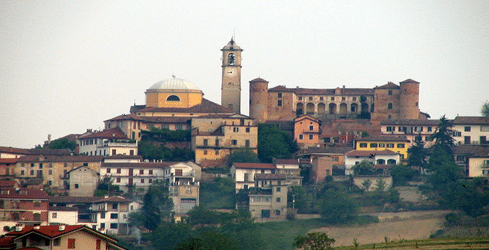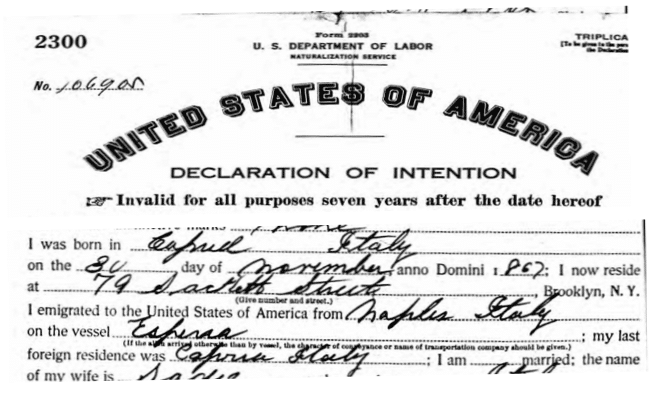I Know My Ancestor is From Italy, but Where Exactly?
 16
16Jul

If you have Italian ancestors, then you should know that Italian immigration had an enormous effect on the growth of America in the 19th century. In the 1880s, Italian immigrants numbered 300,000. It rose to 600,000 in the 1890s and in the next decade it topped more than two million. By 1920, over four million Italians had relocated to the United States and represented over 10% of the nation’s foreign-born population. Italians were leaving the poverty and political unrest of the newly “unified” Italy and were seeking better opportunities in this young country.
The experience of Ellis Island was a confusing push of humanity as they moved through the bureaucratic process of physical and mental inspections, the reporting of names and places of origin and new destinations, and attempted to prove their ability to work in America. As many as 5,000 immigrants per day were rushed through this maze of hurdles.
“The regulations were confusing, the crowds disorienting, the officials rushed, and the hubbub of countless competing languages must have been jarring to the nerves. The moment of departure, when successful immigrants boarded ferries for New York City or destinations further west, came as a tremendous relief.”[1]
It is completely understandable that your ancestor did not push to correct the inspector’s interpretation and writing of their names or other pertinent information as they were trying to move through this process quietly and quickly. They wanted to get through it without causing any issues that would cause them to be detained a moment longer.
So where do you find information on the region of Italy and particularly the village they left behind?
ITALIAN ANCESTORS
WHERE TO LOOK FOR THE VILLAGE OF ORIGIN
You can locate important records, notices and documents in a variety of free and subscription websites like FamilySearch.org, Newspapers.com, GenealogyBank.com and Ancestry.com. Here are five ideas on how to find that sometimes elusive village.
- The Immigration Record. Even though the information may not be complete or even correct, it is wise to start with the immigration record of your ancestor. Sometimes they reported exactly the village they were from, sometimes the province where they were from (“Palermo” or “Trento”), sometimes the port of departure (“Napoli”) and, many times they just said “Italy.” Just like we often say we are from “L.A.,” when in fact we are from Whittier, it is understandable when our ancestors gave a general area or simply the province. Most Americans do not know where Whittier is located in California, let alone someone from a different country.
For example, the ancestor in the record below stated on the Immigration Passenger List[2] that he was from “Isernia,” which is a village and a province. Research was conducted in the village’s vital records in hopes that this person meant the village of Isernia rather than the Isernia Province. It was quickly determined this was a correct assumption as numerous birth records, marriage records and death records were discovered in the village of Isernia.

- The Marriage Record. If your ancestors met and were married in the United States, seek out the Marriage Certificate. It will sometimes list the exact village[3] of origin (Salemi), or sadly on occasion will just say Italy.[4]

- The Naturalization Record. When an ancestor files the Declaration of Intention[5] to acquire citizenship in the United States they have to fill out a wonderfully informative form. If filled out thoroughly it can give the exact village where they were born, such as Capua, Italy, in the example below. This person sailed from Naples, and the last foreign residence was in Capua. This form also gave the date of birth for the ancestor – 30 November 1867 and the current residential address.

- Funeral Notices. In Italy it is tradition to create a funeral card or a Santini with the patron saint of the village on it. Your grandparents or great-grandparents probably kept all of these cards as they hold a special significance to the family. If you cannot locate any of these in the photo albums of your relatives, check the family Bible as they are often kept there. The patron saint can give a clue to which village they were born in.
Also, in the funeral notice[6] of the American newspaper where your ancestor died you will often find a notation of the exact location where your ancestor was born.
- Other People’s Trees. When a search for any additional information on your ancestor is difficult to find, it is suggested to browse FamilySearch.org and Ancestry.com on Public Member Trees that have already been built. Clues can often be found by searching the spouse’s name. Someone in the in-law line there could be information on your ancestor, including important documents and articles and sources you have never seen. This is a great resource to obtain clues to the village of origin. When putting in names to search, be sure to not select “Match All Terms Exactly.” We all know that names can be spelled in a variety of ways by other families and even within our own family. Look at every source that is attached to these trees as they could hold the very clues you are seeking.
Our Italian ancestors were incredibly courageous and hopeful as they embarked on their amazing adventure in an unknown land! They put everything from their homeland behind them and looked forward with the dream of making a better life for themselves and their growing families. If we truly desire to know the family traditions, the reasons for relocating and the history of our ancestors, we must locate the village from whence they came. We need to study the historical facts and historical persons from that village and come to understand their hearts and motivations. And always, if we want to more deeply understand them, we must walk in their footsteps in that village. Go find the relatives that are still living there, probably in the very home your ancestor left from. Your cousins are still there in that beautiful little village and they want to know about you!
Our researchers at Price Genealogy are ready to help you break through to your ancestors from the old country . . . from beautiful Italy!
by Pam
Photo: CC BY-SA 3.0 FIle: Montegrosso d'asti.jpg by Faberti - Own work https://en.wikipedia.org/wiki/Montegrosso_d'Asti#/media/File:Montegrosso_d'asti.jpg
[1] Library of Congress, Immigration and Relocation in U.S. History, L’Isola dell Lagrime (www.loc.gov : accessed July 2021), The Island of Tears – The Ellis Island Experience.
[2] New York, U.S., Arriving Passenger and Crew Lists, 1820-1957, 19 Dec 1919, List #76, (www.ancestry.com : Accessed March 2021), Page 2.
[3] New York Department of Health, Vital Statistics, Brooklyn (New York) marriage records, 1866-1937, FamilySearch (www.familysearch.org :accessed January 2021), FH Library Film #1653135.
[4] New York Department of Health, Vital Statistics, Manhattan (New York) marriage records, 1866-1937, FamilySearch (www.familysearch.org : accessed March 2021), FH Library Film #1493577.
[5] Petition for Naturalization, Ancestry (www.ancestry.com : accessed May 2021) New York, U.S., State and Federal Naturalization Records, 1794-1943, (Roll 218) Vol 109 Page 191 - Vol 110 Page 227, dated 21 April 1922 in New York, Image 2300.
[6] Youngstown Vindicator Newspaper Obituaries, 20 February 1958, Page 21, Column 4 (www.news.google.com : accessed July 2021).
Do you have Italian ancestors? Let us know in a comment below!
